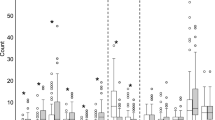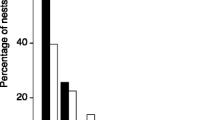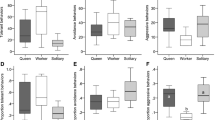Abstract
Circle tube experiments on the primitively eusocial bee, Halictus ligatus, were performed for a variety of combinations of caste and size. Push, Lunge, and Back without reverse behaviors enabled us to determine the dominant individual in most comparisons. Behavioral differences were readily detected within the first 15 min except for different-size forager–forager and same-size foundress–foundress pairs, for which 30 min of observations was required. In same-size forager–forager pairs, no differences in behaviors between individuals were detected even after 90 min. In extended observations, decreases in the frequency of the mild dominant behaviors were accompanied by a switch to the highly aggressive mandibular hold on the neck, particularly in different-size foundress–foundress and gyne–gyne pairs. Three workers were killed by their own queen as a result of this escalation of aggression. We discuss caste-based differences in the circle tube setting in terms of behaviors expected under more normal conditions and compare our data with published results from other species.
Similar content being viewed by others
REFERENCES
Batra, S. W. (1964). Behavior of the social bee, Lasioglossum zephyrum, within the nest (Hymenoptera, Halictidae). Insectes Soc. 2: 159-186.
Batra, S. W. (1966). The life cycle and behavior of the primitively eusocial bee, Lasioglossum zephyrum (Halictidae). Univ. Kans. Sci. Bull. 46: 359-423.
Bell, W. (1974). Recognition of resident and non-resident individuals in intraspecific nest defense of a primitively eusocial halictine bee. J. Comp. Physiol. 93: 195-202.
Bell, W. J., and Hawkins, W. A. (1974). Patterns of intraspecific agonistic interactions involved in nest defense of a primitively eusocial halictine bee. J. Comp. Physiol. 93: 183-193.
Bell, W. J., Breed, M. D., Richards, K. W., and Michener, C. D. (1974). Social, stimulatory and motivational factors involved in intraspecific nest defense of a primitively eusocial halictine bee. J. Comp. Physiol. 93: 173-181.
Bourke, A. F. G. (1988). Worker reproduction in the higher eusocial Hymenoptera. Quart. Rev. Biol. 63: 291-311.
Breed, M. D. (1977). Interactions among individuals and queen replacement in a eusocial halictine bee. Proceedings, VIIIth Congress IUSSI, Wageningen; The Netherlands, pp. 228-231.
Breed, M. D., and Gamboa, G. J. (1977). Behavioral control of workers by queens in primitively eusocial bees. Science 195: 694-695.
Breed, M. D., Silverman, J. M., and Bell, W. J. (1978). Agonistic behavior, social interactions, and behavioral specialization in a primitively eusocial bee. Insectes Soc. 25: 351-364.
Brothers, D. J., and Michener, C. D. (1974). Interactions in colonies of primitively eusocial bees. III. Ethometry of division of labor in Lasioglossum zephyrum (Hymenoptera: Halictidae). J. Comp. Physiol. 90: 129-168.
Buckle, G. R. (1982). Queen-worker behavior and nesmate (sic) interactions in young colonies of Lasioglossum zephyrum. Insectes Soc. 29: 125-137.
Buckle, G., and Greenberg, L. (1981). Nestmate recognition in sweat bees (Lasioglossum zephyrum): Does an individual recognize its own odor or only odors of its nestmates? Anim. Behav. 29: 802-809.
Costa, J. T., and Fitzgerald, T. D. (1996). Developments in social terminology: Semantic battles in a conceptual war. Trends Ecol. Evol. 11: 285-289.
Duffield, R. M., Fernandes, A., Lamb, C., Wheeler, J. W., and Eickwort, G. C. (1981). Macrocyclic lactones and isopentenyl esters in the Dufour's gland secretion of halictine bees (Hymenoptera: Halictidae). J. Chem. Ecol. 7: 319-331.
Fletcher, D. J. C., and Ross, K. G. (1985). Regulation of reproduction in eusocial Hymenoptera. Annu. Rev. Entomol. 30: 319-343.
Free, J. B., Weinberg, I., and Whiten, A. (1969). The egg-eating behavior of Bombus lapidarius L. Behaviour 35: 313-317.
Goukon, K., Maeta, Y., and Sakagami, S. F. (1988). Seasonal changes in ovarian state in a eusocial halictine bee, Lasioglossum duplex, based on stages of the oldest oocytes in each ovariole (Hymenoptera: Halictidae). Res. Popul. Ecol. 29: 255-269.
Greenberg, L. (1979). Genetic component of bee odor in kin recognition. Science 206: 1095-1097.
Hediger, H. (1964). Wild Animals in Captivity, Dover, New York.
Humason, G. (1973). Animal Tissue Techniques, W. H. Freeman, San Francisco.
Kaitala, V., Smith, B. H., and Getz, W. M. (1990). Nesting strategies of primitively eusocial bees: Amodel of nest usurpation during the solitary stage of the nesting cycle. J. Theor. Biol. 144: 445-471.
Kamm, D. R. (1974). Effects of temperature, day length, and number of adults on the sizes of offspring in a primitively social bee. J. Kans. Entomol. Soc. 47: 8-18.
Knerer, G. (1980). Biologie und sozialverhalten von bienenarten der gattung Halictus Latreille (Hymenoptera: Halictidae). Zool. Jb. Syst. 107: 511-536.
Knerer, G. (1992). The biology and social behavior of Evylacus malachurus (K.) (Hymenoptera; Halictidae) in different climatic regions of Europe. Zool. Jb. Syst. 119: 261-290.
Kukuk, P. (1992a). Cannibalism in social bees. In Elgar, M. A., and Crespi, B. J. (eds.), Cannibalism: Ecology and Evolution Among Diverse Taxa, Oxford University Press, Oxford.
Kukuk, P. F. (1992b). Social interactions and familiarity in a communal halictine bee Lasioglossum (Chilalictus) hemichalceum. Ethology 91: 291-300.
Kukuk, P. F., and Decelles, P. C. (1986). Behavioral evidence for population structure in Lasioglossum (Dialictus) zephyrum female dispersion patterns. Behav. Ecol. Sociobiol. 19: 233-239.
Kukuk, P. F., Breed, M. D., Sobti, A., and Bell, W. (1977). The contributions of kinship and conditioning to nest recognition and colony member recognition in a primitively eusocial bee, Lasioglossum zephyrum (Hymenoptera: Halictidae). Behav. Ecol. Sociobiol. 2: 319-327.
McConnell-Garner, J., and Kukuk, P. (1997). Behavioral interactions of two solitary, halictine bees with comparisons among solitary, communal and eusocial species. Ethology 103: 19-32.
Michener, C. D. (1974). The Social Behavior of Bees: A Comparative Study, Harvard University Press, Cambridge, MA.
Michener, C. D. (1977). Aspects of the evolution of castes in primitively eusocial insects. Proceedings, VIIIth Congress IUSSI, Wageningen, The Netherlands, pp. 2-6.
Michener, C. D. (1990). Reproduction and castes in social halictine bees. In Engels, W. (ed.), Social Insects: An Evolutionary Approach to Castes and Reproduction, Springer-Verlag, Berlin.
Michener, C. D., and Brothers, D. J. (1974). Were workers of eusocial Hymenoptera initially altruistic or oppressed? Proc. Natl. Acad. Sci. USA 71: 671-674.
Michener, C. D., and Wille, A. (1961). The bionomics of a primitively social bee, Lasioglossum inconspicuum. Univ. Kans. Sci. Bull. 42: 1123-1202.
Michener, C. D., Brothers, D. J., and Kamm, D. R. (1971). Interactions in colonies of primitively eusocial bees: Artificial colonies of Lasioglossum zephyrum. Proc. Natl. Acad. Sci. USA 68: 1241-1245.
Packard, J. M., Babbitt, K. J., Hannon, P. G., and Grant, W. E. (1990). Infanticide in captive collared peccaries (Tayassu tajacu). Zoo Biol. 9: 49-53.
Packer, L. (1986a). Aspects of the social biology of Halictus ligatus Say (Hymenoptera: Halictidae), Ph.D. thesis, University of Toronto, Toronto.
Packer, L. (1986b). Multiple-foundress associations in a temperate population of Halictus ligatus (Hymenoptera; Halictidae). Can. J. Zool. 64: 2325-2332.
Packer, L. (1987). Competition over oviposition in subtropical and temperate populations of the social sweat bee Halictus ligatus. In Eder, J., and Rembold, H. (eds.), Chemistry and Biology of Social Insects, Verlag J. Peperny, Munchen.
Packer, L. (1993). Multiple foundress associations in sweat bees. In Keller, L. (ed.), Queen Number and Sociality in Insects, Oxford University Press. Oxford.
Packer, L., and Knerer, G. (1986). An analysis of variation in the nest architecture of Halictus ligatus in Ontario. Insectes Soc. 33: 190-215.
Packer, L., and Owen, R. E. (1994). Relatedness and sex ratio in a primitively eusocial halictine bee. Behav. Ecol. Sociobiol. 34: 1-10.
Paxton, R. J., Kukuk, P. F., and Tengo, J. (1999). Effects of familiarity and nestmate number on social interactions in two communal bees, Andrena scotica and Panurgus calcaratus (Hymenoptera, Andrenidae). Insectes Soc. 46: 109-118.
Richards, M. H., Packer, L., and Seger, J. (1995). Unexpected patterns of parentage and relatedness in a primitively eusocial bee. Nature 373: 239-241.
Roseler, P. F., and van Honk, C. G. J. (1990). Castes and reproduction in bumblebees. In Engels, W. (ed.), Social Insects: An Evolutionary Approach to Castes and Reproduction, Springer-Verlag, Berlin.
Sakagami, S. F., and Wain (1966). Halictus latisignatus Cameron: Apolymorphic Indian halictine bee with caste differentiation. J. Bombay Natur. Hist. Soc. 63: 57-73.
Smith, B. H. (1983). Recognition of female kin by male bees through olfactory signals. Proc. Natl. Acad. Sci. USA 80: 4551-4553.
Smith, B. H. (1987). Effects of genealogical relationship and colony age on the dominance hierarchy in the primitively eusocial bee Lasioglossum zephyrum. Anim. Behav. 35: 211-217.
Smith, B. H., and Weller, C. (1989). Social competition among gynes in halictine bees: The influence of bee size and pheromones on behavior. J. Insect Behav. 2: 397-411.
Smith, B. H., and Wenzel, J. H. (1988). Pheromonal covariation and kinship in social bee Lasioglossum zephyrum (Hymenoptera: Halictidae). J. Chem. Ecol. 14: 87-94.
Smith, B. H., Carlson, R. G., and Frazier, J. (1985). Identification and bioassay of macrocyclic lactone sex pheromones of halictine bee Lasioglossum zephyrum. J. Chem. Ecol. 11: 1447-1456.
Sokal, R. R., and Rohlf, F. J. (1995). Biometry, 3rd ed., W. H. Freeman, New York.
Wcislo, W. T. (1997). Elements of dominance behavior and social interactions in a solitary bee, Lasioglossum (Dialictus) figueresi (Hymenoptera: Halictidae). Insectes Soc. 44: 199-208.
Wheeler, D. E. (1986). Developmental and physiological determinants of caste in social Hymenoptera: Evolutionary implications. Am. Nat. 128: 13-34.
Wilson, E. O. (1971). The Insect Societies, Harvard University Press, Cambridge, MA.
Wilson, E. O. (1975). Sociobiology: A New Synthesis, Harvard University Press, Cambridge, MA.
Winston, M. L. (1987). The Biology of the Honey Bee, Harvard University Press, Cambridge, MA.
Zar, J. H. (1984). Biostatistical Analysis, Prentice Hall, Englewood Cliffs, NJ.
Author information
Authors and Affiliations
Rights and permissions
About this article
Cite this article
Pabalan, N., Davey, K.G. & Packer, L. Escalation of Aggressive Interactions During Staged Encounters in Halictus ligatus Say (Hymenoptera: Halictidae), with a Comparison of Circle Tube Behaviors with Other Halictine Species'. Journal of Insect Behavior 13, 627–650 (2000). https://doi.org/10.1023/A:1007868725551
Issue Date:
DOI: https://doi.org/10.1023/A:1007868725551




